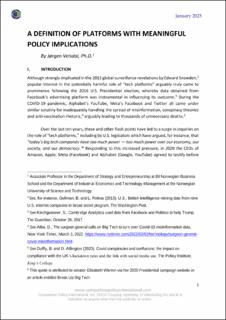| dc.description.abstract | While the term “platform” is ubiquitous in everyday language, its precise definition in the context of topics related to competition, policy and antitrust still remains ambiguous. This arguably for technical reasons which are trivial to grasp but seemingly difficult to communicate en masse. When political leaders take aim at regulating “platforms,” precisely which types of services are they talking about? Do Microsoft’s platforms warrant the same attention from regulators as Meta’s or Alphabet’s? Technically, what distinguishes one from the other and what are the implications of the differences for policy makers? This paper takes aim at clarifying what, technically, constitutes a “platform” that is interesting from the perspective of competition and policy. | en_US |
